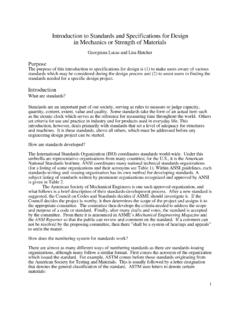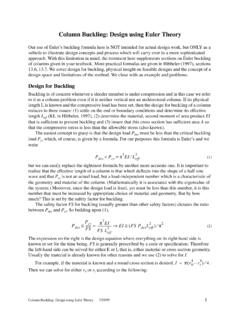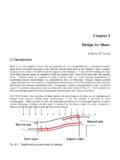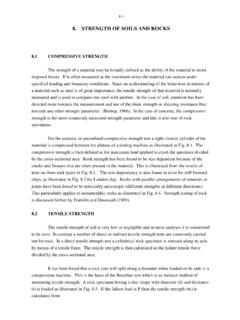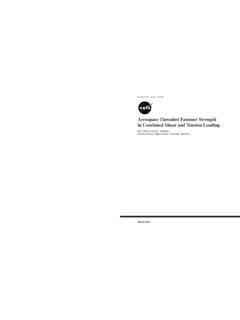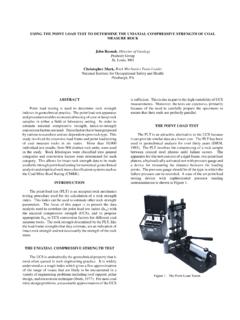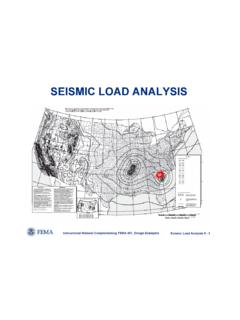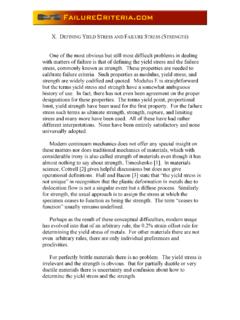Transcription of Bending: Design for Strength, Stiffness and Stress ...
1 bending : Design for strength , Stiffness and Stress Concentrations7/6/991 bending : Design for strength , Stiffness and Stress ConcentrationsThis overview of the theory for Design for bending of beams is meant to supplement that given in your textbook. It is based upon the Bernoulli Euler theory which is applicable to most common engineering applications. First we cover Design for strength because for safety reasons structural integrity is engineering s first priority. Second we cover Design for Stiffness , but doing so in this order does not mean that strength always controls the Design (see the example). After commenting on Stress concentrations and limitations at this level of knowledge, we close with an example and for StrengthOnce the loading scenarios are determined, we can draw shear and moment load diagrams for a beam under each scenario.
2 For example, if we know the load for a beam, but its location is uncer-tain, then for one scenario we would locate the load to achieve a maximum moment; for the other we would locate it to achieve maximum shear. Let s say a simply-supported beam is to carry a concentrated force P, then for scenario 1 locate P at midspan and for scenario 2, locate P just inside either support. Further, if the cross section is rectangular of area A, then the maximum shear Stress equals P/A (by simple shear!) for Scenario 2 rather than 3P/4A (by flexural shear) for Scenario 1. Can you show both of these results? And by doing so, thereby convince yourself that consideration of critical load scenarios is beam Design the normal Stress obtained from maximum moment Mmax usually dominates over shear Stress obtained from maximum shear Vmax (but for exceptions, see limitations below).
3 Therefore, our first choice to obtain the section geometry is to use(1)where S is the so-called section modulus, c is the maximum value of y and the allowable Stress would be known. For example, if the cross section is rectangular of dimensions b h so that I = bh3/12 and c = h/2, then S = bh2/6. Hence knowing either b or h, we can use (1) to get the other. Next for this geometry, we must check the shear Stress using either or both of the following:(2)and then demonstrate that where the allowable shear Stress would be known. If this check fails, then one must determine the geometry from (2) and check that . Other-wise we could compute geometry for each case and compare dimensions to reach a decision, but this approach provides a less evident argument and should be a second choice.
4 A change in cross section geometry along the beam presents a further consideration. For this, see the section on Stress concentrations in bending for StiffnessTo Design for Stiffness , an allowable kinematic condition must be specified. For beam bending , MyI--------MIy --------==S Ic--Mmax all-------------== maxVmaxQmax()Itmin() = , if the shear is due to flexure maxVmaxA = , if the shear is not due to flexure (simple shear case) max all max all bending : Design for strength , Stiffness and Stress Concentrations7/6/992this would normally be a bound upon deflection v like . Although less likely, a maxi-mum slope could be specified instead. Once a model with appropriate boundary conditions has been established, the maximum deflection or slope would be obtained using either double integra-tion of the moment equation or a table for the solution.
5 The relevant equations in sequence are(3)where value is obtained by substituting the location of maximum deflection x into the deflection equation obtained from the differential equation in (3). This is illustrated in the example Concentration EquationsStress concentrations in bending arise when uniformity of geometry is disrupted. In this case, a Design problem may become iterative if initially we do not know the beam geometry required to determine the Stress concentration factor. Then the Design algorithm is: 1) solve the problem for dimensions of a uniform prismatic beam, 2) determine the Stress concentration factor for the dis-ruption in the uniform beam and use it to check if allowables are violated, and 3) repeat until opti-mal dimensions which satisfy all requirements are found.
6 Hibbeler (1997) provides Stress concentration factors for symmetric fillets and grooves in the top and bottom of beams. Factors for geometries including holes and both one-sided and circum-ferential grooves under bending , torsion and axial deformation are given using Neuber s diagram by Ugural and Fenster (1979). But a more general and very reliable source is Roark and Young (1975). When applying formulas from any source, it is important to note the definition of the nominal or reference Stress and the Stress concentration factor Bernoulli-Euler theory is very good, its application above is for elementary Design of straight beams; we neither considered curved beams (Hibbeler, 1997, ) nor accounted for: in which the shear Stress in the beam is the same order of magnitude as the normal Stress .
7 This occurs if large shear loads are applied or the beam is short. Principle stresses, obtained using transformation equations or Mohr s circle (see Hibbeler, ), become important, particularly in concentrations at flange-to-web junctions. Short beams do not flex much and their deflection is due mainly to shear, not moment. A beam is said to be short if its length is less than 10 times its section depth1. This situation is covered in advanced buckling and rotational instability of beams which involves three cases: global buckling of the structure (it buckles as a unit) which is covered subsequently in these notes; local buck-ling which is localized failure of a compression region in a beam ( , waviness in a web or local kinking); and torsional or twisting instability in thin-walled members related to shear flow (Hibbeler, , 75).
8 Nonetheless, this methodology will carry the day in many situations, but the engineer must always be aware of hazardous or special situations and alert all involved Definition of a short beam is due to Zhuravskii, 1821-1891, and is discussed in Gere and Timoshenko (1997).vmaxvall EIx22ddvMx()=EIvmax value=IvalueEvmax-------------- bending : Design for strength , Stiffness and Stress Concentrations7/6/993 ExampleBD1. Design a round chinning bar to fit between a jamb 32 in wide and support a 270 lb person. Client specifica-tions are: (1) minimize weight, (2) set grip spread to 18 in as shown in the figure, (3) diameter of bar to be about 1 in, (4) minimize deflection and limit it to 1/2 in and(5) use a factor of safety FS = Solution:1.
9 For minimum weight, spec #1, choose 6061-T6 aluminum tube or pipe. Properties from Hib-beler (1997): E = 10 106 psi, Y = 37 ksi, Y = 19 ksi. Divide yield stresses by factor of safety FS to get allowables all = 37 = ksi, all = 19 = ksi. (NOTE: Ryerson (1987-89) gives Y = 37 ksi for Alclad Al 6061-T61 and Y = 40 ksi for Al 6061-T6. Our use of the lower value for this material is conservative and therefore safe.)2. Prescribe the loading scenarios. The most critical load will occur if the person hangs from the bar with one hand. This is an obvious possibility and will cover the client s spec #2. Ranked in order from the most critical (Students should show this!), the loading scenarios are:Scenario 1: Central concentrated load.
10 Maximum moment occurs if the entire load is placed in the center of the bar. This will also generate a maximum 2: One-sided concentrated load. Significant (but unknown) simple shear occurs if the load is placed very near to either support, say the Prescribe the models for each scenario. Scenario 1: Scenario 2: 4. Freebody diagram and statics for Scenario 1 Clearly FA = FB = Vmax = 135 lbMmax @ center = (135)(16) = 2160 in lb(Note: Students should draw V-M diagrams to verify these max values.)5. strength Design for Scenario 1:Client spec #3 Set r0 = = in and solve for ri where these are the outer and inner radii, respectively. Using Eq. 1, Check catalog (Ryerson, 1987-89) for aluminum tube with nominal size nearest to 1" OD.
